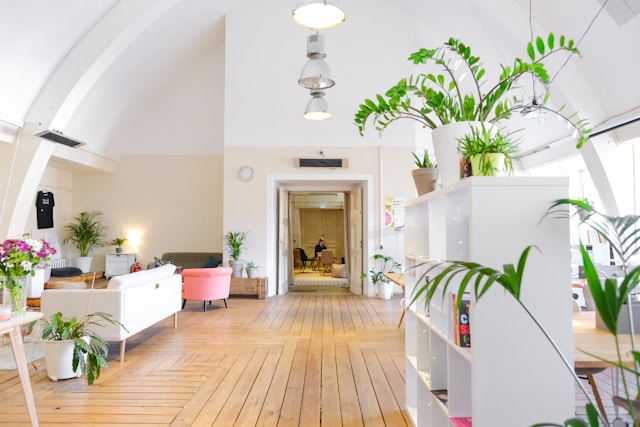Is your workplace healthy? how do you know? Often it’s not an on-site gym or salad bar, but the invisible factor that determines how health-conscious an office space is.
Tiny details that you may not be aware of can impact your overall productivity or even your attitude towards your job. If morale is low in your workplace, investigating these six areas can reveal why your employees aren’t feeling well.
1. Lighting
Did you know that fluorescent lights contain invisible pulses? You might not notice it, but one in seven employees who suffer from migraines will. Anyone who’s ever been sick knows the impact pain can have on your productivity.
Natural light is best, as 70% of workers say sunlight exposure directly leads to increased work output. However, not every office space has an abundance of windows and skylights. Your next best option is a soft LED, preferably with a soothing green or blue undertone, as many people find this hue relaxing and helpful with concentration. Light strips, floor lamps, and table lamps allow you to direct lighting where you need it.
2. Flooring and Sound Considerations
Imagine the crunch of 30 pairs of high heels on the concrete floor surrounding the metal warehouse. Just thinking about it makes people cover their ears. Offices can become noisy with competing phone conversations and meetings, as well as poor acoustics.
Carpets may harbor nasty bacteria, but that’s less of a problem in a workplace than in a home with a crawling baby. Ceilings with acoustic tiles can eliminate warehouse echoes. Allowing employees to wear headphones (or at least an earbud) can also increase productivity. Many neurodiverse people find that these devices help them focus and reduce anxiety.
3. Fresh air
The COVID-19 pandemic has brought home how important it is to maintain HVAC systems in the workplace. Additionally, Americans lose 3.5 million work days each year due to allergies (which are sometimes indistinguishable from colds). Change filters and use windows to provide light and ventilation. If you need to replace, choose an open model instead of fixed panes.
Plenty of research shows the healing power of the outdoors, but how do you harness it when workers work from sunup to sundown? Provide a pleasant outdoor seating area—perhaps on a green roof in an urban area—so employees can stretch their legs in the fresh air.

4. Lounge design
Your outdoor space can double as a secondary lounge, especially if you add some heaters and umbrellas for summer shade. Almost every office space has a snack machine, but you usually have some control over what’s inside. Can you add dried fruit chips, jerky, cheese sticks and vegetables to your chips and candies?
Coffee is already rich in antioxidants, which may fight cognitive decline and even cancer. However, adding some herbal tea is a great option. Staff can add some healing turmeric and ginger to their coffee, or sip lavender and chamomile to calm down after a tough meeting.
5. Seats
Poor seating can lead to chronic back pain, leading to more frequent illness. The cost of providing suitable office chairs to all employees is relatively low.
However, one size fits all is rarely the right solution. Some employees may prefer variable-height desks to transition from sitting to standing throughout the day. Others may occasionally want to swap their office chair for an inflatable exercise ball. Surveying your employees or letting them try different chair sizes shows that you care about their health.
6. People-oriented concept
What is “work”? How do you know when you’re done with everything and where will you fly after? Mars? The reality is that work, whether paid or unpaid, will always be a part of life. Besides, life is what you make it, and it’s the good times spent with good people that make it worthwhile.
The healthiest office spaces recognize this reality and prioritize people over the need for productivity. This doesn’t mean paying employees to be lazy, but, in the words of executive coach Sam Adeyemi, “caring about people before getting things done.” It’s more than just not dismissing those who call out caring for sick kids and digging deeper. For example, if an employee is not producing, this triggers gentle questioning about why and what support they need to thrive.
Ironically, more work gets done in such workplaces. Happy employees are less likely to jump ship, and the dividends of having a stable team year after year far outweigh the benefits of a domineering manager’s control over a revolving door team. Additionally, employees who feel supported will yell less and be more likely to step up at legitimate critical moments and minimize complaints because they know they will get a break later.
Invisible office space health factors
Your office may appear healthy enough on the outside, but frequent sick days can cause problems. These unseen factors can impact productivity. Make your business a place people want to work by taking appropriate steps to improve the overall health of your facility.
 About the Author
About the Author
Oscar Collins is the editor-in-chief of Modded and writes about health and fitness. Follow him on Twitter @TMModded Get regular updates on his work and subscribe to Modded Minute to learn more!

